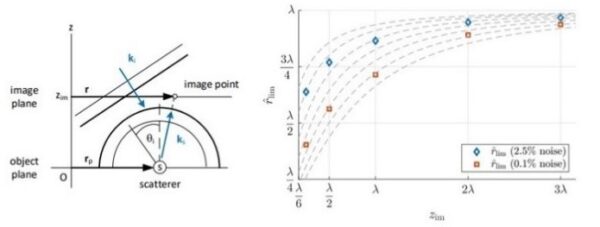Solving the inverse scattering problem in the intermediate field and numerical experiment
October 4, 2025
Near surfaces, optical waves interfere and generate standing waves. These can be detected using an optical fiber probe. In this work, we demonstrate how nanostructures can be imaged by solving the inverse scattering problem in the intermediate field. Our results indicate that optical resolution is highly dependent on the distance between the surface and the imaging plane. Through numerical experiments, we show that super-resolution is achievable when the separation between the emitter and the imaging plane is less than half the wavelength.
As opposed to popular far-field and near-field optical microscopy techniques, Interference Scanning Optical probe Microscopy (ISOM) operates in the intermediate-field region, where the probing distance is typically of the order of the wavelength of incident light. Specifically, ISOM enables the imaging of nanostructures through numerical inverse scattering of standing waves generated by the interference between the incident (or reflected) and scattered waves.
In this work, we shed new light on this microscopy modality through an in-depth Fourier analysis. Our analysis reveals insights on the required acquisition sampling step as well as on the resolution limit of the system. Moreover, we propose two novel numerical methods to address the associated inverse scattering problem, leveraging the intrinsic structure of the image formation model to reduce computational complexity and sensitivity to errors in model parameters. Finally, we illustrate our theoretical findings with numerical experiments.
Fourier analysis of ISOM, offers new perspectives on its imaging capabilities. Our analysis showed that while, in an ideal noiseless setting, the recorded image carries unlimited frequency bands, high-frequency information undergoes strong exponential attenuation. This observation led us to introduce the notion of effective resolution limit, balancing frequency attenuation against noise level. Numerical experiments confirmed that measured resolutions closely align with our theoretical predictions. As expected, the resolution decreases when either the probing distance zim or the noise level increases.
In this study, we used the simplest Tikhonov regularizer to validate our theoretical framework. However, incorporating more sophisticated priors would undoubtedly enhance reconstruction performance. In particular, it is now well established that learned priors, using deep neural networks can significantly enhance the resolution of imaging inverse problems and ISOM. Imaging distances suitable for achieving super-resolution (i.e., below λ/2) typically range between λ/6 and λ, depending on the noise level.
Future research will include experimental validation to verify ISOM’s practical resolution against our theoretical findings, as well as a comparative analysis. Advancing acquisition and reconstruction methods for real-time nanoscale motion observation represents a promising direction for future research.

Schematic representation of the incident and scattered optical waves from a point-like emitter (left), and the optical resolution as a function of the distance zimz_{im}zim between the emitter and the image plane, as well as the noise level (right).
[Header image: Interferograms (a, b) and reconstructions (c, d) at distances between the image and substrate (zm) of half (a, d) and quarter (b, c) wavelengths]
Contact:
Wolfgang Bacsa | wolfgang.bacsa[at]cemes.fr
Publication:
Fourier Analysis of Interference Scanning Optical Probe Microscopy
E. Soubies and W. Bacsa
IEEE Transactions on Computational Imaging, 2025, 11, pp.1206 – 1216.
DOI: https://doi.org/10.1109/TCI.2025.3603741


